User:JMvanDijk/Sandbox 9/Box 6/Box 4
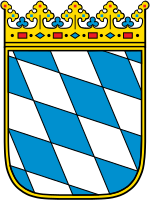
The following is a list of monarchs during the
.Monarchs of Bavaria
Ducal Bavaria (also known as the "Old Stem duchy")
Agilolfing dynasty
Around 548 the kings of the
| Name | Image | Title | Start term | End term | Part | Note |
|---|---|---|---|---|---|---|
| Garibald I | Duke of Bavaria | 555 (c.) | 591 | Some sources call him "King of the Bavarians".[1] | ||
| Tassilo I | Duke of Bavaria | 591 (c.) | 610 | Named rex (king) at his ascension. | ||
| Garibald II | Duke of Bavaria | 610 (c.) | 630 | |||
| Theodo | Duke of Bavaria | 680 (c.) | 716 (?) | By the time of Theodo, who died in 716 or 717, the Bavarian duchy had achieved complete independence from the Frankish kings. Theodo's sons divided the duchy, but by 719 the rule had returned to Grimoald. | ||
| Theodbert | Duke | 702 (c.) | 719 | Salzburg | Son of Theodo. | |
| Theobald | Duke | 711 (c.) | 719 | Parts of Bavaria | Son of Theodo. | |
| Tassilo II | Duke | 716 (c.) | 719 | Passau | Son of Theodo. | |
| Grimoald | Duke | 716 (c.) | 725 | Freising | Son of Theodo, later ruling all of Bavaria. | |
| Hugbert | Duke | 725 | 737 | Son of Theudbert. In 725(?), Charles Martel, ruler in fact though not in name of the Frankish realm, reasserted royal supremacy over Bavaria, defeating and killing Grimoald and annexing portions of Bavaria during the rule of Hugbert. | ||
Odilo |
737 | 748 | Son of Gotfrid. | |||
| Grifo | 748 | 748 | Carolingian Usurper. | |||
Tassilo III |
Duke of Bavaria | 748 | 788 | In 757 Frankfurt am Main in 794.
|
Carolingian dynasty and dominion from the Holy Roman Empire
The kings (later emperors) of the Franks now assumed complete control, placing Bavaria under the rule of non-hereditary governors and civil servants. They were not dukes but rather kings of Bavaria. Emperor Louis the Pious divided control of the Empire among his sons, and the divisions became permanent in the decades following his death in 840. The Frankish rulers controlled Bavaria as part of their possessions.
| Name | Image | Title | Start term | End term | Part | Note |
|---|---|---|---|---|---|---|
| Charlemagne |  |
Emperor | 788 | 814 | Prefects of Bavaria: Gerold (794–799) and Audulf (799–818) | |
| Louis the Pious |  |
Emperor | 814 | 826 | In 814, Louis appointed his eldest son Lothair I as governor of Bavaria. In 817, Louis bestowed Bavaria upon his other son, Louis the German, who took charge of the province in 826, as King of Bavaria. | |
| Louis the German |  |
King of Bavaria | 826 | 876 | In 826, Louis started to rule as King of Bavaria, subordinate to his father, until the latter's death in 840. From 843, Bavaria was merged in Louis the German's Kingdom of East Francia. In 864, Louis the German gave control of Bavaria to his son Carloman, and died in 876. Louis' two younger sons, Louis and Charles—the latter of whom briefly recovered control of all the Frankish possessions—ruled Bavaria in succession after Carloman. | |
| Carloman |  |
King of Bavaria | 876 | 880 | Eldest son of Louis the German. | |
| Louis the Younger |  |
King of Bavaria | 880 | 882 | Son of Louis the German. | |
| Charles the Fat |  |
King of Bavaria | 882 | 887 | Youngest son of Louis the German.
Carloman's bastard son, Arnulf of Carinthia, rebelled against Charles and took power in eastern Francia shortly before Charles' death. | |
| Arnulf of Carinthia |  |
King of Bavaria | 887 | 899 | Son of Carloman. | |
| Louis the Child |  |
King of Bavaria | 899 | 911 | Son of Arnulf of Carinthia. | |
| Engeldeo | Margrave of Bavaria | 890 | 895 | Non-dynastic. Deprived of his title marchio Baioariorum and replaced by Luitpold. |
Ducal Bavaria (also known as the "Younger Stem duchy")
Ruled by an array of dukes from an array of rivaling houses, individually appointed to office.
Luitpolding dynasty, 911–947
- Luitpolding dynasty
Luitpold, founder of the
German kings, 947–1070
From 947 until the 11th century, the kings of Germany repeatedly transferred Bavaria into different hands (including their own), never allowing any one family to establish itself. Bavaria was ruled by a series of short-lasting, mostly unrelated dynasties.
Houses of Welf and Babenberg, 1070–1180
- Houses Babenberg
In 1070,
| Name | Image | Title | Start term | End term | House | Part | Note |
|---|---|---|---|---|---|---|---|
| Luitpold | Margrave of Bavaria | 895 | 907 | Luitpolding |
|||
| Arnulf the Bad | Duke of Bavaria | 907 | 920 | Luitpolding |
Son of Luitpold.
Arnulf the Bad claimed the title of duke—implying full autonomy—in 911, and was recognized as such by King Henry the Fowler in 920. | ||
| Eberhard | Duke of Bavaria | 937 | 938 | Luitpolding |
|||
| Berthold |  |
Duke of Bavaria | 938 | 947 | Luitpolding |
Younger son of Luitpold.
The German King Otto I reasserted central authority, banishing Arnulf's son Eberhard and re-granting the title to Berthold, a younger son of Luitpold.
| |
| Henry I |  |
Duke of Bavaria | 947 | 955 | Ottonian | Son of Henry the Fowler.
On Berthold's death, Otto I, Holy Roman Emperor , gave the duchy to his own brother Henry (I), who was also Arnulf the Bad's son-in-law.
| |
| Henry II the Quarrelsome |  |
Duke of Bavaria | 955 | 976 | Ottonian | Henry II made war upon his cousin, Emperor Otto II, and was deprived of his duchy in 976 in favor of his cousin Otto, Duke of Swabia (who now acquired two dukedoms). | |
| Otto I |  |
Duke of Bavaria | 976 | 982 | Ottonian | ||
| Henry III the Younger | Duke of Bavaria | 983 | 985 | Luitpolding |
Bavaria was given to Berthold's son Henry III, briefly restoring the Luitpolding dynasty. Henry III exchanged Bavaria for Carinthia, and Henry II received Bavaria again. | ||
| Henry II the Quarrelsome |  |
Duke of Bavaria | 985 | 995 | Ottonian | Restored | |
| Henry IV |  |
Duke of Bavaria | 995 | 1004 | Ottonian | Son of Henry II the Quarrelsome.
Henry IV was elected as Count of Luxemburg in 1004.
| |
| Henry V | Duke of Bavaria | 1004 | 1009 | Luxemburg |
Son of Siegfried of Luxembourg .
| ||
| Henry IV |  |
Duke of Bavaria | 1009 | 1017 | Ottonian | Henry IV reasserted direct control. | |
| Henry V | Duke of Bavaria | 1017 | 1026 | Luxemburg |
Son of Siegfried of Luxembourg .
Conrad II, Holy Roman Emperor, King of Germany, gave Bavaria to his son Henry VI after the death of Henry V in 1026. | ||
| Henry VI the Black |  |
Duke of Bavaria | 1026 | 1042 | Salian | Son of Conrad II, Holy Roman Emperor.
Later Henry was elected as Holy Roman Emperor Henry III, and became King of Germany in 1039. | |
| Henry VII |  |
Duke of Bavaria | 1042 | 1047 | Luxemburg |
Son of Frederick of Luxembourg.
In 1042, Henry III, Holy Roman Emperor, granted the duchy to Henry VII, Count of Luxemburg, nephew of Henry V. | |
| Conrad I (Kuno) | Duke of Bavaria | 1049 | 1053 | Ezzonen | Son of Liudolf of Lotharingia.
After Henry VII's death, the dukedom was vacant for a couple of years. Henry III, Holy Roman Emperor, then gave the duchy to Kuno, Count of Zütphen, in 1049. Kuno was deposed in 1053. | ||
| Henry VIII |  |
Duke of Bavaria | 1053 | 1054 | Salian | Son of Henry III, Holy Roman Emperor.
During his reign in Bavaria Henry VIII was a minor (born 1050). In 1056 he became King of Germany and Holy Roman Emperor as Henry IV in 1084. | |
| Conrad II | Duke of Bavaria | 1054 | 1055 | Salian | (minor, born 1052, died 1055) Son of Henry III, Holy Roman Emperor | ||
| Henry VIII |  |
Duke of Bavaria | 1055 | 1061 | Salian | (minor: born 1050) Son of Henry III, Holy Roman Emperor. Henry VIII became King of Germany (1056) and Henry IV, Holy Roman Emperor in 1084. | |
| Otto II | Duke of Bavaria | 1061 | 1070 | Nordheim | In 1061 Empress Agnes—the 11-year-old King Henry IV 's mother and regent—entrusted the duchy to Otto of Nordheim.
| ||
| Welf I |  |
Duke of Bavaria | 1070 | 1077 | Welf | Welf I subsequently quarreled with Henry IV, Holy Roman Emperor and was deprived of his duchy for nineteen years, during which it was directly administered by the German crown. | |
| Henry VIII |  |
Duke of Bavaria | 1077 | 1096 | Salian | (minor: born 1050) Son of Henry III, Holy Roman Emperor. Henry VIII became King of Germany (1056) and Henry IV, Holy Roman Emperor in 1084. | |
| Welf I |  |
Duke of Bavaria | 1096 | 1101 | Welf | Welf I recovered the duchy in 1096. | |
| Welf II |  |
Duke of Bavaria | 1101 | 1120 | Welf | Son of Welf I | |
| Henry IX the Black |  |
Duke of Bavaria | 1120 | 1126 | Welf | Son of Welf I.
Abdicated. | |
| Henry X the Proud |  |
Duke of Bavaria | 1126 | 1138 | Welf | Son of Henry IX the Black.
In a power struggle with King Margrave of Austria .
| |
Leopold I |
 |
Duke of Bavaria | 1139 | 1141 | Babenberg |
When Leopold died, Conrad III of Germany resumed the duchy and granted it to Leopold's brother Henry XI. | |
| Henry XI Jasomirgott |  |
Duke of Bavaria | 1143 | 1156 | Babenberg |
Brother of Leopold. | |
| Henry XII the Lion |  |
Duke of Bavaria | 1156 | 1180 | Welf | When Frederick I, Holy Roman Emperor , became king of Germany, he restored Bavaria to the Welf line in the person of Henry X's son, Henry XII the Lion, Duke of Saxony.
|
Ducal and Electoral Bavaria (Hereditary dukes)

In 1180,
First partition, 1253–1340
In 1253, on Otto II's death, Bavaria was divided between his sons. Henry became Duke of Lower Bavaria and Louis of Upper Bavaria. From this point until the beginning of the 16th century, the territories were frequently divided between brothers, making the Dukes difficult to list.
In Lower Bavaria, Henry XIII was succeeded by his three sons, Otto III, Louis III, and Stephen I ruling jointly. Otto III's successor in the joint dukedom was his son Henry XV. Stephen's successors were his sons Otto IV and Henry XIV. Henry XIV's son was John I.
In Upper Bavaria, Louis II was succeeded by his sons Rudolf I and Louis IV. The latter was elected King of Germany in 1314. After John I's death in 1340, Louis IV unified the Bavarian duchy.
The dukes of Upper Bavaria served also as Counts Palatinate of the Rhine. In 1329 Louis IV released the Palatinate of the Rhine including the Bavarian Upper Palatinate to the sons of Rudolf I. The Upper Palatinate would be reunited with Bavaria in 1623, the Lower Palatinate in 1777.
Second partition 1349–1503
From 1349 until 1503 the second partition of Bavaria took place. In 1349, the six sons of Louis IV partitioned Bavaria into Upper and Lower Bavaria again. In 1353, Lower Bavaria was partitioned into
Following the Landshut War (1503–1505), the Duke of Bavaria-Munich Albert IV the Wise became ruler of Bavaria. In 1506 Albert decreed that the duchy should pass according to the rules of primogeniture.
In 1623 Maximilian I was granted the title Prince-elector (German: Kurfürst) of the Rhenish Palatinate.
House of Wittelsbach
Partitions of Bavaria under Wittelsbach rule
| Duchy of Bavaria (1180–1253) | ||||||||
| Lower Bavaria (1st creation) (1253–1340) |
Upper Bavaria (1st creation) (1253–1340) | |||||||
| Duchy of Bavaria (Upper line) (1340–1349) | ||||||||
| Lower Bavaria (2nd creation) (1349–1353) |
Upper Bavaria (2nd creation) (1349–1363) (divided among the other duchies) | |||||||
| Landshut (1353–1503) |
||||||||
| Straubing (1353–1432) (divided among the other duchies) | ||||||||
| Munich (1392–1503) |
Ingolstadt (1392–1445) |
|||||||
| Dachau (1467–1501) |
||||||||
| Leuchtenberg (1646-1705) |
Duchy of Bavaria (Munich line) (1503–1623) Raised to: Electorate of Bavaria (1623-1806) | |||||||
Table of rulers
(Note: Here the numbering of the dukes is the same for all duchies, as all were titled Dukes of Bavaria, despite of the different parts of land and its particular numbering of the rulers. The dukes are numbered by the year of their succession.)
| Ruler | Born | Reign | Death | Ruling part | Consort | Notes | |
|---|---|---|---|---|---|---|---|
Otto III the Redhead |
 |
1117 | 1180–1183 | 11 July 1183 | Bavaria | Agnes of Loon 1169 eleven children |
In 1180 Otto I Wittelsbach, Duke of Bavaria of the House of Wittelsbach .
|
| Regency of Agnes of Loon (1183-1189) | Son of Palatinate of the Rhine in 1214. So Louis I served also as Count Palatine of the Rhine. He was assassinated 1231.
| ||||||
| Louis I the Kelheimer |  |
23 December 1173 | 1183–1231 | 15 September 1231 | Bavaria | Ludmilla of Bohemia 1204 one child | |
Otto IV the Illustrious |
 |
7 April 1206 | 1231–1253 | 29 November 1253 | Bavaria | Agnes of the Palatinate 1222 Worms eleven children |
Otto IV served also as Count Palatine of the Rhine. On Otto IV's death, Bavaria was divided between his sons. Henry became duke of Lower Bavaria, and Louis of Upper Bavaria. From this point until the beginning of the 16th century, the territories were frequently divided between brothers. |
| Henry XIII |  |
19 November 1235 | 1253–1290 | 3 February 1290 | Lower Bavaria | Elizabeth of Hungary 1250 ten children |
Son of Otto IV . After the partition of 1253, received Lower Bavaria.
|
| Louis II the Strict |  |
13 April 1229 | 1253–1294 | 2 February 1294 | Upper Bavaria | Maria of Brabant 2 August 1254 (executed) no children Anna of Głogów 1260 two children Matilda of Austria 24 October 1273 four children |
Son of Otto IV . After the partition of 1253, received Upper Bavaria.
|
| Otto V | 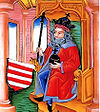 |
11 February 1261 | 1290–1312 | 9 November 1312 | Lower Bavaria | Catherine of Austria January 1279 two children Anna of Głogów 18 May 1309 two children |
Sons of Henry XIII, ruled jointly. In 1305 Otto became also Croatia, as grandson of Béla IV of Hungary .
|
| Louis III | 9 October 1269 | 1290–1296 | 9 October 1296 | Lower Bavaria | Isabella of Lorraine 1287 no children | ||
| Stephen I | 14 March 1271 | 1290–1310 | 10 December 1310 | Lower Bavaria | Judith of Świdnica-Jawor 1299 eight children | ||
| Regency of Matilda of Austria (1294-1296) | Sons of Louis II, ruled jointly. In 1317 Rudolph abdicated of his rights to his brother, who in 1328 was elected Holy Roman Emperor. louis had already been elected King of Germany in 1314. In the Treaty of Pavia (1329) Louis IV released the Palatinate of the Rhine passing the Bavarian Upper Palatinate to the sons of Rudolf I. After John I the Child's death in 1340, Louis IV unified the Bavarian duchy. | ||||||
| Rudolph I the Stammerer |  |
4 October 1274 | 1294–1317 | 12 August 1319 | Upper Bavaria | six children | |
| Louis IV the Bavarian | 
|
5 April 1282 | 1294–1340 | 11 October 1347 | Upper Bavaria | Beatrice of Świdnica-Jawor 14 October 1308 six children Margaret II, Countess of Holland-Hainaut 26 February 1324 Cologne ten children | |
| 1340–1347 | Bavaria | ||||||
| Regency of Louis IV, Duke of Bavaria (1312-19) | Sons of Stephen I (Henry XIV and Otto VI) and Otto V (Henry XV), ruled jointly. | ||||||
| Henry XIV the Elder | 29 September 1305 | 1312–1339 | 1 September 1339 | Lower Bavaria | Margaret of Bohemia 12 August 1328 two children | ||
| Otto VI | 3 January 1307 | 1312–1334 | 14 December 1334 | Lower Bavaria | Richardis of Jülich 1330 one child | ||
| Henry XV the Natternberger | 28 August 1312 | 1312–1333 | 18 June 1333 | Lower Bavaria | Anna of Austria between 1326 and 1328 no children | ||
| Regency of Louis IV, Duke of Bavaria (1339-40) | Left no male heirs, which allowed his cousin (and brother-in-law) Louis to reunite the Bavarian lands. | ||||||
| John I the Child | 29 November 1329 | 1339–1340 | 20 December 1340 | Lower Bavaria | Anna of Upper Bavaria 18 April 1339 Munich no children | ||
| Louis V the Brandenburger | 
|
May 1315 | 1347–1349 | 18 September 1361 | Bavaria | Meran four children |
The six sons of Louis IV, ruled jointly until 1349, when they divided the land: Louis V, Louis VI and Otto VII kept Upper Bavaria; William, Albert and Stephen Lower Bavaria. In 1351 Louis VI and Otto gave up their inheritance in Bavaria, in exchange of the Electoral dignity in Brandenburg . Having lost the Electorate of Brandenburg in 1373, Otto returned to Bavaria to claim new inheritance, and shared the part of Stephen II's sons (his nephews) in Landshut.
In Lower Bavaria, the three brothers divided the land again in 1353: Stephen kept Landshut, William and Albert shared Straubing, and from 1389 the two shared Straubing also with Albert I's son, Albert II. |
| 1349–1361 | Upper Bavaria | ||||||
Louis VI the Roman
|

|
7 May 1328 | 1347–1349 | 17 May 1365 | Bavaria | Ingeborg of Mecklenburg-Schwerin 1360 no children | |
| 1349–1351 | Upper Bavaria | ||||||
| Otto VII the Lazy | 
|
1340/42 | 1347–1349 | 15 November 1379 | Bavaria | Catherine of Bohemia 19 March 1366 no children | |
| 1349–1351 | Upper Bavaria | ||||||
| 1375–1379 | Bavaria-Landshut | ||||||
| Stephen II the Representative | 
|
1319 | 1347–1349 | 13 May 1375 | Bavaria | Elisabeth of Sicily 27 June 1328 four children Margaret of Nuremberg 14 February 1359 three children | |
| 1349–1353 | Lower Bavaria | ||||||
| 1353–1375 | Bavaria-Landshut | ||||||
| William I the Mad | 
|
12 May 1330 | 1347–1349 | 15 April 1389 | Bavaria | Matilda of England 1352 London no children | |
| 1349–1353 | Lower Bavaria | ||||||
| 1353–1389 | Bavaria-Straubing | ||||||
| Albert I | 
|
25 July 1336 | 1347–1349 | 13 December 1404 | Bavaria | Margaret of Brzeg after 19 July 1353 Passau seven children Margaret of Clèves 1394 Heusden no children | |
| 1349–1353 | Lower Bavaria | ||||||
| 1353–1404 | Bavaria-Straubing | ||||||
Albert II |
 |
1368 | 1389–1397 | 21 January 1397 | Bavaria-Straubing | Unmarried | |
| Meinhard I |  |
9 February 1344 | 1361–1363 | 13 January 1363 | Upper Bavaria | Margaret of Austria 4 September 1359 Passau no children |
Left no male descendants. After his death Upper Bavaria was divided between Bavaria-Landshut and Bavaria-Straubing. |
| Definitively annexed by Bavaria-Landshut (1/2) and Bavaria-Straubing (1/2) | |||||||
| Frederick I the Wise | 1339 | 1375–1393 | 4 December 1393 | Bavaria-Landshut | Anna of Neuffen 1360 one child Maddalena Visconti 2 September 1381 five children |
Ruled jointly. Shared rule, until 1379, with their uncle Otto VII. In 1392 the brothers divided the land once more. Frederick retained Landshut, Stephen kept Ingolstadt and John received Munich. | |
| Stephen III the Magnificent | 1337 | 1375–1392 | 26 September 1413 | Bavaria-Landshut | Taddea Visconti 13 October 1364 two children Anna of Neuffen 16 January 1401 Cologne no children | ||
| 1392–1413 | Bavaria-Ingolstadt | ||||||
| John II | 1341 | 1375–1392 | 14 June/1 July 1397 | Bavaria-Landshut | Catherine of Gorizia 1372 three children | ||
| 1392–1397 | Bavaria-Munich | ||||||
| Regencies of Maddalena Visconti and Stephen III, Duke of Bavaria (1393-1401), John II, Duke of Bavaria (1393-97), Ernest, Duke of Bavaria and William III, Duke of Bavaria (1397-1401) | Annexed Ingolstadt in 1445. | ||||||
| Henry XVI the Rich |  |
1386 | 1393–1450 | 30 July 1450 | Bavaria-Landshut | six children | |
| Ernest |  |
1373 | 1397–1438 | 14 June/1 July 1397 | Bavaria-Munich | Elisabetta Visconti 26 January 1395 Pfaffenhofen an der Ilm four children |
Ruled jointly. |
| William III |  |
1375 | 1397–1435 | 12 September 1435 | Bavaria-Munich | Margaret of Cleves 1433 two children | |
| William II |  |
5 April 1365 | 1404–1417 | 31 May 1417 | Bavaria-Straubing | Margaret of Burgundy 12 April 1385 Cambrai one child |
Eldest son of Albert I. |
| Louis VII the Bearded |  |
1368 | 1413–1443 | 1 May 1447 | Bavaria-Ingolstadt | 1413 two children |
Imprisoned by his son, who was allied with Henry XVI. Died in prison. |
John III the Pitiless |
 |
1374 | 1417–1425 | 6 January 1425 | Bavaria-Straubing | Elizabeth I, Duchess of Luxembourg 11418 no children |
Son of Albert I. Contested Jacqueline, the heiress of the Wittelsbach possessions in the Low Countries, until his death. |
| Definitively annexed by the remaining Bavarian duchies | |||||||
| Albert III |  |
27 March 1401 | 1438–1460 | 29 February 1460 | Bavaria-Munich | ten children |
Son of Ernest. |
| Louis VIII the Hunchback | 1 September 1403 | 1443–1445 | 7 April 1445 | Bavaria-Ingolstadt | Unmarried | After his death Ingolstadt was annexed by Landshut. | |
| Definitively annexed by Bavaria-Landshut | |||||||
| Louis IX the Rich |  |
23 February 1417 | 1450–1479 | 18 January 1479 | Bavaria-Landshut | Amalia of Saxony 21 March 1452 Landshut four children |
|
| John IV | 4 October 1437 | 1460–1463 | 18 November 1463 | Bavaria-Munich | Unmarried | Son of Albert III, ruled jointly with his brothers Sigismund and Albert IV. | |
Sigismund
|

|
26 July 1439 | 1460–1467 | 1 February 1501 | Bavaria-Munich | Unmarried | In 1467, Sigismund created a smaller duchy with its center in Dachau, but left no descendants, and this duchy was merged again in Bavaria-Munich after his death. |
| 1467–1501 | Bavaria-Dachau | ||||||
| Definitively annexed by Bavaria-Munich | |||||||
| George I the Rich | 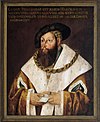 |
15 August 1455 | 1479–1503 | 1 December 1503 | Bavaria-Landshut | Hedwig of Poland 14 November 1475 Landshut five children |
Left no male descendants at his death. His duchy was annexed to Bavaria-Munich, which reunited the Bavarian duchy. |
| Albert IV the Wise | 
|
15 December 1447 | 1460–1503 | 18 March 1508 | Bavaria-Munich | Kunigunde of Austria 3 January 1487 Munich seven children |
Co-ruled with his brothers John IV and Sigismund. Reunited the duchy in 1503. In 1506 Albert decreed that the duchy should pass according to the rules of primogeniture. |
| 1503–1508 | Duchy of Bavaria | ||||||
| William IV the Steadfast |  |
13 November 1493 | 1508–1550 | 7 March 1550 | Duchy of Bavaria | four children |
Sons of Albert IV, the last Bavarian pair of brothers ruling together. |
| Louis X |  |
18 September 1495 | 1516–1545 | 22 April 1545 | Duchy of Bavaria | Unmarried | |
| Albert V the Magnanimous |  |
29 February 1528 | 1550–1579 | 24 October 1579 | Duchy of Bavaria | Anna of Austria 4 July 1546 Regensburg seven children |
|
| William V the Pious |  |
29 September 1548 | 1579–1597 | 7 February 1626 | Duchy of Bavaria | Renata of Lorraine 22 February 1568 Munich ten children |
|
| Maximilian I the Great |  |
17 April 1573 | 1597–1651 | 27 September 1651 | Duchy of Bavaria (until 1623) Electorate of Bavaria (from 1623) |
two children |
Children of Electorate of the Palatinate in 1623.
Albert VI inherited from his wife the lands of Leuchtenberg, and from 1646 reorganizes them as a new Bavarian duchy, the short-lived Duchy of Bavaria-Leuchtenberg. |
| Albert VI |  |
26 February 1584 | 1646-1666 | 5 July 1666 | Duchy of Bavaria-Leuchtenberg | Mechtild of Leuchtenberg (24 October 1588 – 1 June 1634) 8 December 1650 five children | |
| Regency of Albert VI, Duke of Bavaria (1651-1654) | Son of Maximilian I. | ||||||
| Ferdinand Maria | 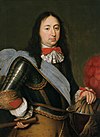 |
31 October 1636 | 1651-1679 | 26 May 1679 | Electorate of Bavaria | Henriette Adelaide of Savoy 8 December 1650 eight children | |
| Maximilian Philip Hieronymus |  |
30 September 1638 | 1666-1705 | 20 March 1705 | Duchy of Bavaria-Leuchtenberg | Mauricienne Fébronie de La Tour d’Auvergne (1652-1706) 1668 Château-Thierry no children |
Son of Maximilian I, inherited his uncle Albert VI's possessions. His childless death led to the union of the Bavarian Leuchtenberg lands and the Electorate. |
| Annexed to the Electorate of Bavaria | |||||||
| Regency of Maximilian Philipp Hieronymus, Duke of Bavaria-Leuchtenberg (1679-1680) | Took part in the War of the Spanish Succession on the side of France, against Leopold I, Holy Roman Emperor. He was accordingly forced to flee Bavaria following the Battle of Blenheim and deprived of his Electorate on 29 April 1706. He regained his Electorate in 1714 by the Peace of Baden and ruled until 1726. | ||||||
| Maximilian II Emanuel |  |
11 July 1662 | 1679-1726 | 26 February 1726 | Electorate of Bavaria | Maria Antonia of Austria 15 July 1685 Vienna three children Theresa Kunegunda Sobieska 15 August 1694 Warsaw (by proxy) ten children | |
| Charles Albert | 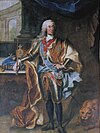 |
6 August 1697 | 1726-1745 | 20 January 1745 | Electorate of Bavaria | Maria Amalia of Austria 5 October 1722 Vienna seven children |
Took on the House of Habsburg in the War of the Austrian Succession, again in combination with France, succeeding so far as to be elected Holy Roman Emperor in 1742 (as Charles VII). However, the Austrians occupied Bavaria (1742–1744), and the Emperor died shortly after returning to Munich. |
| Maximilian III Joseph the Beloved |  |
28 March 1727 | 20 January 1745 | 30 December 1777 | Electorate of Bavaria | Maria Anna Sophia of Saxony 9 July 1747 no children |
As he had no children, was the last of the direct Bavarian Wittelsbach line descended from Elector of the Palatinate, Charles Theodore, who thereby regained their old titles for the senior Wittelsbach line—descended from Louis IV's older brother Rudolf I .
|
| Charles Theodore | 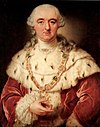 |
11 December 1724 | 1777-1799 | 16 February 1799 | Electorate of Bavaria (merged with Electoral Palatinate) |
Elisabeth Augusta of Palatinate-Sulzbach 17 January 1742 Mannheim one child Maria Leopoldine of Austria-Este 15 February 1795 Hofburg, Innsbruck no children |
Son of John Christian, Count Palatine of Sulzbach and Marie Anne Henriëtte Leopoldine de La Tour d'Auvergne. Distant cousin of Maximilian III; Elector Palatine from 1743. Charles Theodore was also childless, and was succeeded by a distant cousin, the Count Palatine of Zweibrücken, Maximilian IV Joseph—later King Maximilian I. |
| Maximilian IV Joseph |  |
27 May 1756 | 1799-1806 | 6 August 1806 | Electorate of Bavaria (merged with Electoral Palatinate) |
eight children |
Son of Count Palatine Frederick Michael of Zweibrücken. ; Count Palatine of Zweibrücken from 1795.Distant cousin of Charles Theodore In the chaos of the wars of the French Revolution, the old order of the Holy Roman Empire collapsed. In the course of these events, Bavaria became once again the ally of France, and Maximilian IV Joseph became King Maximilian I of Bavaria—whilst remaining Prince-Elector and Arch-steward of the Holy Roman Empire until 6 August 1806, when the Holy Roman Empire was abolished. |
Kingdom of Bavaria
In 1805 under the Peace of Pressburg between the Napoleonic France and the Holy Roman Empire several duchies were elevated to kingdoms. The Wittelsbach rulers of Bavaria held the title King of Bavaria from 1806 until 1918. The prince-elector of Bavaria, Maximilian IV Joseph formally assumed the title King Maximilian I of Bavaria on 1 January 1806. The well-known so called Märchenkönig (Fairy tale king) Ludwig II constructed Neuschwanstein Castle, Herrenchiemsee, and Linderhof Palace during his reign (1864–1886), threatening not only to go bankrupt in person, but also to bankrupt the country in the process. In 1918 Ludwig III lost his throne in the German Revolution of 1918–1919.
| Name | Image | Title | Start term | End term | House | Note |
|---|---|---|---|---|---|---|
| Maximilian I |  |
King of Bavaria | 1 January 1806 | 13 October 1825 | Wittelsbach | see above |
Ludwig I |
 |
King of Bavaria | 13 October 1825 | 20 March 1848 | Wittelsbach | Son of Maximilian I Joseph.
Abdicated in the Revolutions of 1848
|
| Maximilian II |  |
King of Bavaria | 20 March 1848 | 10 March 1864 | Wittelsbach | Son of Ludwig I
|
| Ludwig II |  |
King of Bavaria | 10 March 1864 | 13 June 1886 | Wittelsbach | Son of Maximilian II
Ludwig II was called the Märchenkönig (Fairy tale king). He grudgingly acceded to Bavaria becoming a component of the German Empire in 1871, was declared insane in 1886.[2] |
| Otto |  |
King of Bavaria | 13 June 1886 | 5 November 1913 | Wittelsbach | Brother of Ludwig II and son of Maximilian II.
From a mathematical, calendrical point of view, his marked the longest "reign" amongst the Kings of Bavaria. However, Otto was mentally ill since teenhood and throughout all of his later life, hence the royal functions had to be carried out by the following princes regent:
|
| Ludwig III |  |
King of Bavaria | 5 November 1913 | 13 November 1918 | Wittelsbach | Cousin of Ludwig I .
Prince regent from 1912 until 1913. Declared King of Bavaria following a controversial change of the constitution, discharging his cousin Otto from "office". Lost the throne in the German Revolution of 1918–1919 at the end of World War I. Marks the end of 738 years of uninterrupted Wittelsbach rule over Bavaria. |
Post-monarchy
In 1918, at the end of the
- Series Ducum Bavariæ calls him Garibaldus rex, see FMG.
- ISBN 978-1-55972-362-6
